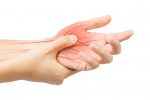Limited Joint Mobility of Diabetes May Be Early Sign of Scleroderma
Juvenile SSc diagnosed in boy with type 1 diabetes and telltale hand issues
Written by |

The case of a 14-year-old boy with diabetes provided a starting point for a finding of juvenile systemic sclerosis (SSc): the limited joint mobility evident in the boy’s fingers can be an initial sign of underlying SSc, the report’s researchers suggested.
Although “the coexistence of diabetes with juvenile systemic sclerosis is rarely described … the association between [the two conditions] may be more than a coincidence, and could suggest a relationship between glucose metabolism, fibrosis and microangiopathy [small blood vessel disease],” the scientists, in Italy and Canada, wrote.
The case report “Juvenile diabetes and systemic sclerosis: just a coincidence?” was published in the journal Pediatric Rheumatology.
The prevalence of limited joint mobility in adults with diabetes is estimated to range from 8% to 58% and to be around 7% in children with type 1 diabetes. About one-third of these children, especially those with moderate to severe diabetes, develop diabetic sclerodactyly, or a hardening of the skin on the hand that causes fingers to curl inward. This feature is also associated with limited joint mobility.
Diabetes at age 4, Raynaud’s phenomenon at age 12
The boy was diagnosed with type 1 diabetes when he was 4 years old and treated “without complication.” At age 12, a first instance of Raynaud’s phenomenon was noted to affect his hands. In Raynaud’s, the fingers and toes feel numb, prickly, or frigid in response to cold or emotional distress.
He later reported pain, a poorer range of motion in his finger joints, and tight skin along the back of the fingers, and was diagnosed with sclerodactyly, erythema (i.e., redness of the skin) around the fingernails, and thick and tapered fingers. He also had contractures in his finger joints, elbows, and wrists.
Laboratory tests revealed high levels of antinuclear antibodies (ANAs), anti-Ro-52, and anti-Mi-2b; tests for other scleroderma-related antibodies such as anti-Scl-70, anti-centromere, and anti-U1RNP were negative.
Nailfold capillaroscopy, an imaging technique used to analyzed changes in small blood vessels under the fingernails, revealed an “active” scleroderma pattern, including a disorganized microvasculature.
Further examinations found he had interstitial lung disease, a condition characterized by fibrosis or scar tissue in the lungs, and cardiac symptoms — specifically, mild evidence of dysfunction in the heart’s left ventricle. But he had no signs of pulmonary hypertension or scarring in the heart (myocardial fibrosis).
According to established criteria for SSc, the boy presented several symptoms supporting a juvenile SSc (jSSc) diagnosis. He was treated with mofetil mycophenolate at a dose of 600 mg per square meter per day, resulting in a significant improvement in pulmonary function and finger joint range of motion at a follow-up six months later.
“The coexistence of [type 1 diabetes] with juvenile systemic sclerosis (jSSc) is anecdotal,” the researchers wrote. “Only three other case reports have described a similar association between [SSc] and [type 1 diabetes].”
According to the team, this case posed a “major diagnostic dilemma” in differentiating diabetic skin hardening with limited joint motion from skin changes associated with systemic sclerosis. Some specific SSc aspects, such as Raynaud’s phenomenon, finger tapering, positive autoantibodies, interstitial lung disease, and cardiac involvement, allowed them to distinguish the two conditions.
“The test that most facilitated the differentiation of jSSc from a scleroderma-like syndrome was [nailfold] capillaroscopy, which showed an ‘active scleroderma pattern’ in our patient,” the researchers added.
A “plausible” hypothesis for the co-occurrence of type 1 diabetes and juvenile SSc could be mechanisms behind the microvascular changes common to both, they suggested, noting further research was necessary.
Findings in this case and the three others reported, the team concluded, could “help clarify the pathogenesis of SSc itself and may raise important implications for future treatment strategies … to downregulate fibrosis in jSSc.”






